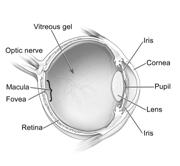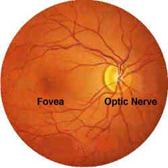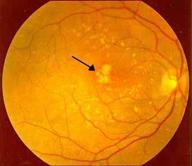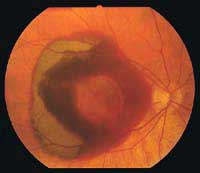
Aged related macular degeneration (ARMD or AMD) is an eye disease that affects central vision. It specifically targets the macula which is the central portion of the retina. The retina, if you think of your eye like a camera, is like the film. It receives light and then sends a message through your optic nerve to the brain. The brain then interprets these signals into the images you see.
AMD affects over 13 million people just in the United States. In AMD, deterioration of retinal cells leads to blind spots or distortion of central vision. This makes it difficult to read or recognize faces in late stages. In its early stages there may be little or no symptoms. Therefore, it is important to have regular DILATED eye exams every year after age fifty. Check your eyes daily by covering one at a time to make sure there is no vision loss. You should see an eye doctor immediately if you see things that should be straight are angled or crooked.
As the name implies, the older a person is the higher their risk of AMD. Other risk factors include family history, light colored eyes, Caucasian race, female gender, smoking, heart disease, and obesity. Sun exposure and low nutritional diet have also been indicated as risks.
There are two forms of AMD, dry and wet. In dry AMD there is damage and thinning of the layer just under the retina. These areas can not absorb light, so the person is missing parts of what they should be seeing. It usually progresses slowly over years. In wet AMD, blood vessels grow through these weak areas like weeds through cracks in the sidewalk. These abnormal blood vessels then bleed and cause swelling which distorts the retina and in turn your vision. Unfortunately, this change can occur overnight! About 10% of those with AMD have the wet form.

Normal retina

Dry AMD

Wet AMD
At this time there is no cure for AMD, but there are treatments to slow it down. A large study by the National Eye Institute called the Age Related Eye Disease Study (AREDS) proved that antioxidant vitamins can slow the progress of dry AMD and decrease the risk of developing the wet form. The study recommends Vit A 28,640 IU, Vit C 452mg, Vit E 400 IU, Zinc 69.6 mg and Copper 1.6 mg. Only individuals considered to be high risk by their eye doctor should be on this regimen. These doses are many times above the recommended daily intake values. High doses of vitamins can be harmful to your health. High doses of Vit A have been shown to increase the risk of lung cancer in smokers. Other supplements now being investigated in AREDS II include zeaxanthin, omega-3-fatty acids (fish oil) and lutein. A lot of people claim bilberry extract and other various herbs are also helpful. Most doctors also recommend a healthy diet including green vegetables, oily fish like salmon, and certain nuts.
Wet AMD can be well treated in many patients with injections in the eye. These injections block one of the hormones called vasoendothelial growth factor (VEGF) which helps the abnormal blood vessels grow and leak fluid. There are several types of medications in this category. Macugen and Lucentis are both FDA approved specifically for wet AMD. Avastin is FDA approved for treatment of colon and breast cancer and also works very well for wet AMD. The injections are performed in an ophthalmologist or retina specialist office directly through the white portion of the eye or sclera. Usually the injections must be repeated every 4-6 weeks until the swelling and bleeding stops. In a majority of patients vision does improve if treated promptly. Another option is hot or cold laser. Usually laser treatments are combined with anti-VEGF injections or used if injections fail.
Much research is being concentrated on this disease. Hopefully in the near future we will have gene therapy to prevent this deterioration of the macula. As the population ages there will be more and more people loosing their sight.
